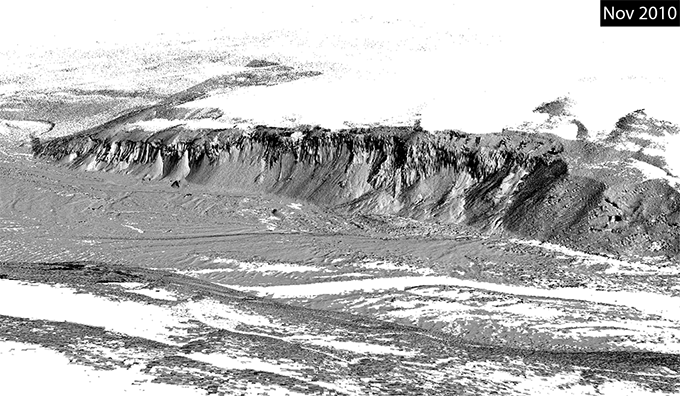Antarctica hasn't experienced the rapid melting that the Arctic has, but that is changing
When it comes to polar melting, the Arctic hogs all the attention. And not without reason—last summer Arctic sea ice melted to its smallest extent on record, 49% below the 1979-2000 average. During the first two weeks of July, sea ice declined 61% faster than the 1981-2000 average, according to the National Snow and Ice Data Center. As sea ice melted, Arctic shipping set a record, with trips quadrupling in 2013 from the year before. The Arctic permafrost—the frozen soil that covers much of the tundra—is melting, which threatens the release of vast amounts of the greenhouse gas methane. Thanks largely to climate change, the Arctic is changing before our very eyes.
The Antarctic, on the other end of the globe, is pretty boring by comparison. Antarctica is losing ice, but not as fast or dramatically as the Arctic is. Relatively little warming has occurred to change the endless ice sheets of Eastern Antarctica, which contain enough frozen water that sea levels would rise by nearly 200 ft. if it all melted. Ice sheets break off in Western Antarctica, which is really more of a series of frozen islands, but altogether the rate of change has been more gradual in the forbidding and largely uninhabited South Pole.
But Antarctica hasn’t always been so relatively stable—and it won’t remain that way in the future.
(MORE: Studies of the Past Show an Ice-Free Arctic Could Be in Our Future [UPDATE])
A new study in the journal Nature Geoscience suggests that large of the East Antarctic Ice Sheet experienced significant melting during the Pleistocene Pliocene epoch*, between 5.3 and 2.6 million years ago, when atmospheric levels of carbon dioxide were similar to where they are today, and temperatures were about 2 to 3 C warmer than they are now. It was a time when sea levels were some 66 ft. higher than they are today—more than high enough to swamp coastal cities. While scientists knew that all of Greenland and West Antarctica had to be ice-free at the time, the sediment data in the Nature Geoscience shows that the East Antarctic ice sheet must have retreated a couple hundred miles inland. “The East Antarctic Ice Sheet has been much more sensitive to climate change in the past than previously realized,” said the study’s lead author, Carys Cook of Imperial College London, in a statement.
In another study, researchers from the University of Texas at Austin found that coastal Antarctic permafrost—which, unlike Arctic permafrost, was considered to be stable—is actually melting much faster than scientists had expected. Researchers had though that the permafrost in the region was in equalibrium—ice would melt during the summer, only to refreeze in the winter. But the Texas study, published in Scientific Reports, shows a rapid melting of permafrost in Antarctica’s Garwood Valley, diminishing the overall mass of ground ice. “The big tell here is that ice is vanishing—it’s melting faster each time we measure,” said Joseph Levy, a research associate at the University of Texas’s Institute for Geophysics and the lead author on the paper.
“That’s a dramatic shift from recent history.”
It’s important to note that global warming is not responsible for the permafrost melt here—that region of Antarctic actually experienced a cooling trend from 1986 to 2000, followed by relatively stable temperatures. The Scientific Letters researchers suggest instead that the melting is due to an increase in radiation from sunlight resulting from changing weather patterns that allow more light to reach the ground during the summer. (In the winter, of course, Antarctica experiences 24-hour darkness.) As the permafrost melts, it actually alters the land surface, creating “retrogressive thaw slumps.” The changes observed in the study are occurring around 10 times faster than the average during the Holocene, the current geological epoch, and can actually be seen with time-lapse photography:



